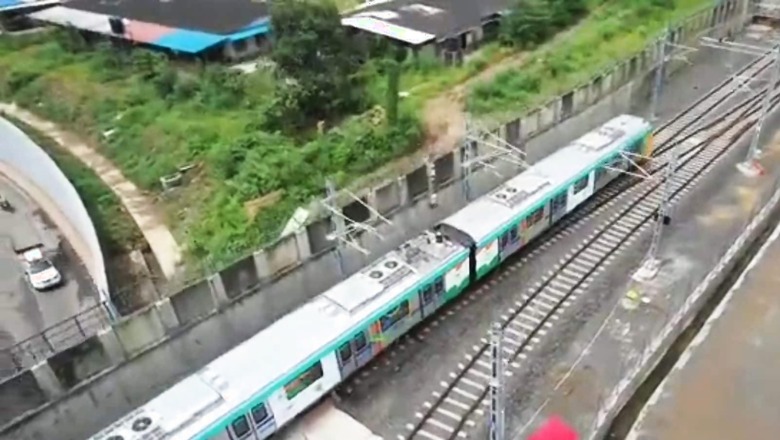
views
The first trial run of Mumbai’s Colaba-Bandra-SEEPZ Metro line 3 was launched on Tuesday at Sariput Nagar in Aarey area at around 11 am.
An important development in the realisation of the controversial line, the run was flagged off by Maharashtra Chief Minister Eknath Shinde and his deputy Devendra Fadnavis. Before giving the green signal, Shinde and Fadnavis examined the Metro train from inside. MMRCL Managing Director Ashwini Bhide was present on the occasion.
Both, Shinde and Fadnavis addressed the crowd. CM Shinde said that the metro would bring relief to the city which relies heavily on local trains which are over-crowded. He also said that the first order they gave after their government was formed was to resume the metro shed work. “We are the people’s government. We are a government that focuses on infrastructure,” he said.
कुलाबा-वांद्रे-सिप्स मेट्रो लाइन-3 च्या प्रोटोटाइप ट्रेन चाचणी शुभारंभ कार्यक्रमातून लाईव्ह https://t.co/KquLnGD20M— Eknath Shinde – एकनाथ शिंदे (@mieknathshinde) August 30, 2022
The Metro line 3, which will be a 33.5 km underground route, will connect Colaba in south Mumbai with the western suburbs.
Here’s everything you need to know about the developments so far:
WHEN DID CONSTRUCTION START?
The Mumbai Metro Rail Corporation Limited (MMRCL) started the work on the 33-km long underground Colaba to SEEPZ line in 2016 with a total of 26 underground station on the entire stretch. Earlier this year, it was announced that it would be extended by 2.5 km from Cuffe Parade to Navy Nagar, and a total of 27 stations will be added with an estimated additional cost of Rs 2,031 crore.
The initial plan was to complete the first phase of the project between Bandra and SEEPZ by December 2021, and the second phase from Bandra-Kurla Complex to Colaba by June 2022. After many delays, the MMRCL is now planning to complete the first phase by January 2024. The Phase 1 stretch between BKC and SEEPZ is scheduled for December 2023 opening.
WHAT WAS THE 10,000 CRORE COST HIKE?
Earlier this month, the first Cabinet meeting of the Eknath Shinde government after expansion approved an increase of Rs 10,000 crore in the overall cost of the project. The cost of the project has risen from Rs 23,136 crore to Rs 33,405 crore, with state government now contributing Rs 3,699.81 crore from the earlier Rs 2,402.7 crore.
One of the reasons for the cost escalation is the time taken in excavation due to basalt rock, adoption of bottom-up construction technology for space needs, addition cost incurred on account of rocky layers and to remove them and erecting steel decks for road traffic to allow building of underground stations in congested areas, according to a report in the Free Press Journal.
Moreover, the Metro 3 project will accommodate eight coaches as against six used by the Delhi Metro.
WHAT IS THE AAREY CAR SHED CONTROVERSY?
One of the major reasons for the increase in cost and delay was the construction of the Metro car shed at Aarey forest, a forested land adjoining the Sanjay Gandhi National Park, which had been met with resistance by citizens and activists in the city, who protested the felling of trees in the area.
After the formation of Maha Vikas Aghadi government in November 2019, chief minister Uddhav Thackeray cancelled the car shed project in Aarey, and announced that the plan be shifted to marshy, salt pan area of Kanjurmarg. The Kanjurmarg area was stuck in litigations and lawsuits, with the Central government claiming stake on the land.
The construction of the Metro car shed at Aarey was one of the first decisions reversed by the current Shinde-Fadnavis government.
Last month, former chief minister Uddhav Thackeray had fervently appealed to the new government “not to stab Mumbai in its heart” by going ahead with the construction of the car shed at Aarey.
WHY DID THE SC ASK TO STOP WORK ON THE CAR SHED?
The Supreme Court last week asked Mumbai Metro to not carry out any work on Aarey forest until next hearing. The Mumbai Metro Rail Corporation Ltd (MMRCL) earlier this month told the Supreme Court no trees have been felled in the Aarey forest region to make way for a metro shed and only “weeds and bushes” have been cleared.
Meanwhile, Chief minister Eknath Shinde made it clear that the government stands by its decision to develop the Metro 3 car shed at Aarey colony while deputy CM Devendra Fadnavis announced that the Colaba-Seepz line would be operational by December 2023 and not a single tree would be cut for the depot.
WHAT WILL BE ITS CONNECTIVITY?
Once completed, the line will connect Mumbai’s key financial hubs such as Nariman Point, Bandra-Kurla-Complex, Fort, Worli, Lower Parel and Goregaon. The metro will provide first-time connectivity to the airport, Nariman Point, Cuffe Parade, Kalbadevi, Worli, BKC, Airport, SEEPZ and MIDC.
The Metro line will be of 33.5 km and the entire stretch will have underground 26 below the surface and 27 elevated stations. It is estimated that 17 lakh passengers will travel by the Metro Line 3 every day by 2031.
The Metro line will cut down on the travelling time between Colaba and the international airport to 50 minutes.
Read all the Latest News India and Breaking News here




















Comments
0 comment